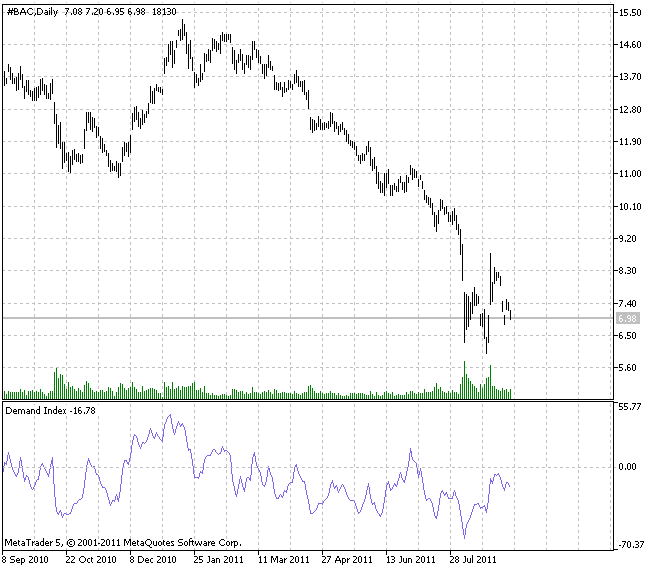Unisciti alla nostra fan page
- Visualizzazioni:
- 80
- Valutazioni:
- Pubblicato:
-
Hai bisogno di un robot o indicatore basato su questo codice? Ordinalo su Freelance Vai a Freelance
L'indice di domanda è stato sviluppato da James Sibbett. Per calcolare questo indice si utilizzano il prezzo e il volume. È considerato un indice anticipatore. In questa interpretazione, per comodità, l'indice viene disegnato su una scala Y da +100 a -100. Per il resto, il calcolo dell'indice è esattamente uguale alla versione dell'autore.
Le regole per l'indice di domanda sono sei:
- La divergenza tra il valore dell'indice e l'andamento dei prezzi supporta l'ipotesi di "debolezza" di un determinato prezzo;
- Quando il mercato si sta riprendendo, le nuove creste dei prezzi sono solitamente precedute da picchi massimi dell'indice di domanda (in questo caso l'indice funziona come indicatore anticipatore);
- Una situazione in cui il prezzo raggiunge un nuovo massimo ma l'Indice è al di sotto del picco precedente accompagna solitamente inversioni superiori "significative" (in questo caso l'Indice funziona come indicatore coincidente);
- L'attraversamento del livello zero da parte dell'Indice indica un cambiamento di tendenza (in questo caso l'Indice agisce come indicatore ritardatario);
- Se il valore dell'Indice rimane vicino al livello zero per qualche tempo, indica l'"inconcludenza" del movimento dei prezzi, che non durerà a lungo;
- Un'ampia divergenza a lungo termine tra i prezzi e i valori dell'Indice suggerisce grandi "crinali" o "fondi".
In questo indicatore è possibile modificare il metodo di calcolo della media, scegliendo tra dieci possibili opzioni:
- SMA - media mobile semplice;
- EMA - media mobile esponenziale;
- SMMA - media mobile smussata;
- LWMA - media mobile lineare ponderata;
- JJMA - media adattiva JMA;
- JurX - media ultralineare;
- ParMA - media parabolica;
- T3 - Smoothing esponenziale multiplo di Tillson;
- VIDYA - media che utilizza l'algoritmo di Tushar Chande;
- AMA - mediazione con l'algoritmo di Perry Kaufman.
Occorre prestare attenzione al fatto che i parametri di tipo Phase hanno significati diversi per i vari algoritmi di mediazione. Per JMA, si tratta di una variabile esterna Phase, che varia da -100 a +100. Per T3 è il fattore di mediazione moltiplicato per 100 per una migliore percezione, per VIDYA è il periodo dell'oscillatore CMO e per AMA è il periodo dell'EMA lento. Negli altri algoritmi, questi parametri non influiscono sulla media. Per AMA, il periodo dell'EMA veloce è fisso e pari a 2 per impostazione predefinita. Anche il fattore di grado per l'AMA è fisso a 2.
L'indicatore utilizza le classi della libreria SmoothAlgorithms.mqh (copiatele nella directory terminal_data_terminal_directory\MQL5\Include); una descrizione dettagliata del loro utilizzo è stata pubblicata nell'articolo "Mediazione delle serie di prezzi senza buffer aggiuntivi per i calcoli intermedi".

Tradotto dal russo da MetaQuotes Ltd.
Codice originale https://www.mql5.com/ru/code/520
 MyComment - new comments added without deleting existing ones.
MyComment - new comments added without deleting existing ones.
Aggiunta di nuovi commenti a un grafico senza cancellare quelli esistenti.
 ServerTime
ServerTime
Uno strumento leggero e personalizzabile che visualizza l'ora del server sul grafico per prendere decisioni di trading precise.
 ZigZag su Parabolica
ZigZag su Parabolica
Questo indicatore costruisce ZigZag sulla base delle letture dell'indicatore tecnico Parabolic SAR.
 Comment
Comment
Un semplice sostituto di un commento. Nel tester funziona 50 volte più velocemente della funzione standard.